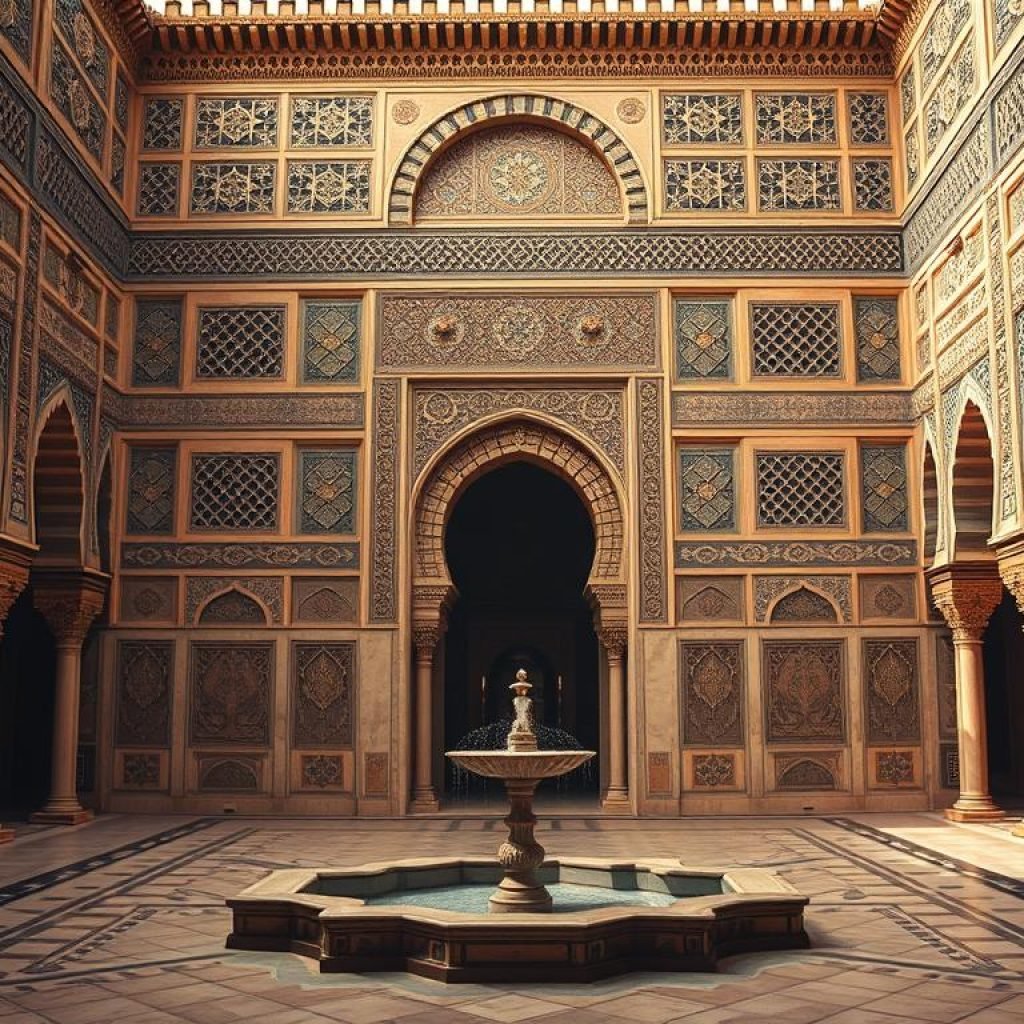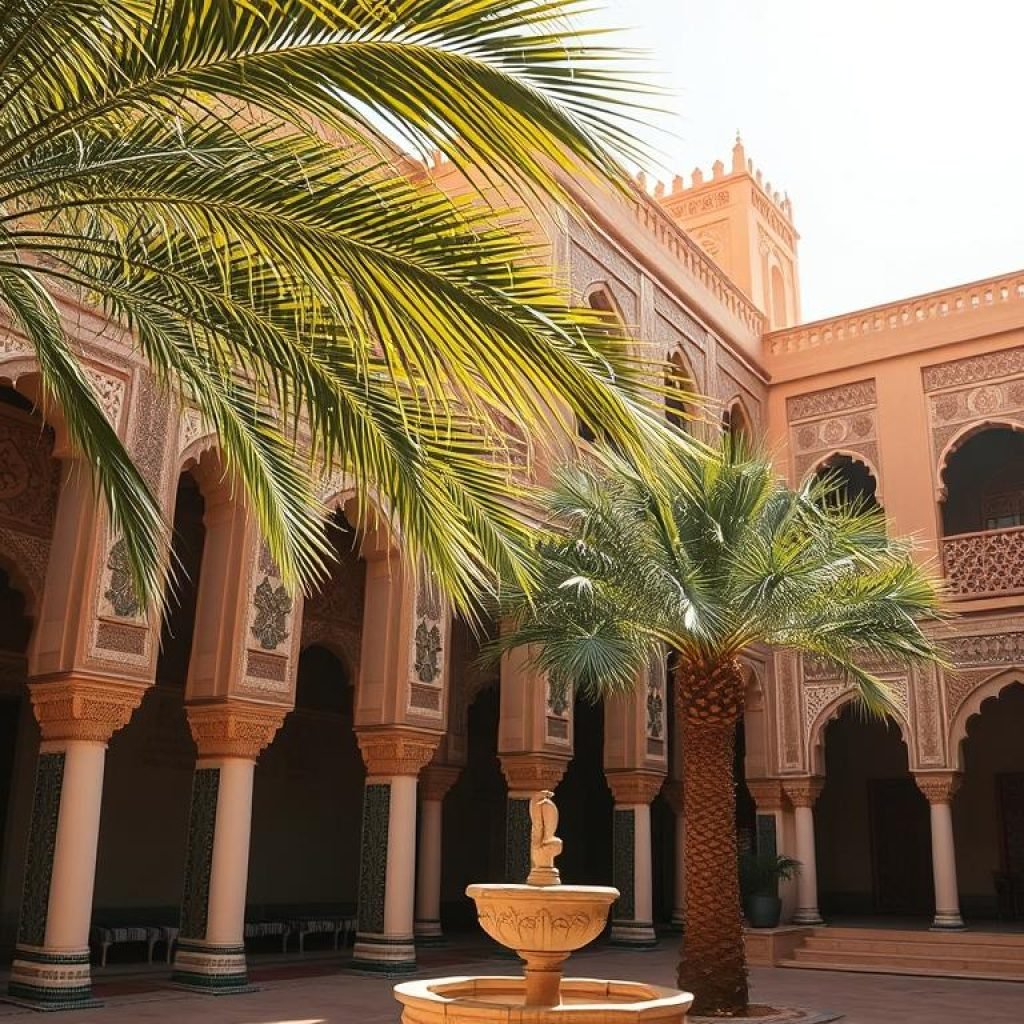What makes Moroccan architecture so unique and captivating? It’s the mix of Moorish, Islamic, and Mediterranean styles. Morocco’s location has made it a cultural crossroads. This has led to a distinct style that shows over 1,900 years of history, starting with the Berber Kingdom in the 2nd century.
To see the best of Moroccan architecture, visit Casablanca. The city offers tours from Casablanca that highlight its traditional design and cultural significance.
Moroccan architecture is a must-see for design and history lovers. It’s filled with intricate tile work and ornate details. The Hassan II Mosque in Casablanca is a standout, with a minaret that reaches 210 meters, one of the tallest in the world.
Zellij tiles are a big part of Moroccan architecture. They show a tradition of geometric patterns and colors. This reflects the country’s rich architectural heritage.
Moroccan architecture is a fascinating mix of styles. It’s a key part of the country’s cultural landscape. Modern cities like Casablanca show how traditional and contemporary designs coexist. The Finance City Tower in Casablanca, finished in 2019, is a prime example of modernist architecture in Morocco.
Key Takeaways
- Moroccan architecture has a unique blend of Moorish, Islamic, and Mediterranean influences.
- The country’s strategic location has made it a crossroads of cultures, resulting in a distinct architectural style.
- Moroccan architecture features intricate tile work, ornate details, and a blend of traditional and contemporary designs.
- The Hassan II Mosque in Casablanca is one of the tallest mosques in the world, with a minaret that stands at 210 meters tall.
- Moroccan architecture includes influences from various periods, with the Islamic architectural style developing significantly from the 7th century onward.
- The country’s architectural heritage is reflected in its traditional design, with notable examples such as the El Bahia Palace in Marrakesh, which was constructed in the late 1800s.
Introduction to Moroccan Architecture
Moroccan architecture is a mix of African, Islamic, and European styles. This mix comes from the country’s location at the crossroads of cultures. Traditional riads and kasbahs show the rich history and culture of North Africa.
Islam has a big impact on Moroccan architecture. Hispano-Moorish architecture emerged during the Almoravid dynasty. It combines Islamic styles with other influences. You can see this in the use of architectural elements like arches, domes, and minarets.
Some key features of Moroccan architecture include:
- Traditional homes, known as riads, have inward-facing courtyards for privacy and weather protection
- Kasbahs, fortified cities, blend in with their surroundings with tan-colored exteriors
- Mosques are found everywhere, with at least one tall minaret
Moroccan architecture showcases the country’s cultural heritage. It combines African, Islamic, and European influences. The use of traditional architectural elements makes Moroccan buildings both beautiful and practical.
Key Characteristics of Moroccan Architecture
Moroccan architecture is a mix of Islamic influences and decorative motifs. It features intricate tile work, arched doorways and windows, and various materials. This creates a unique and stunning style.

Intricate Tile Work
Intricate tile work is a key feature of Moroccan architecture. It includes complex geometric patterns and bright colors. The zellige mosaics add a special touch, often seen on walls, floors, and ceilings.
Arched Doorways and Windows
Arched doorways and windows are also distinctive. Horseshoe arches are a common sight. They’re often paired with intricate tile work and decorative motifs.
Diverse Building Materials
Moroccan architecture uses many materials like clay, stone, and cedar wood. Using local materials shows respect for the region’s resources. It also makes the style sustainable.
The blend of Islamic influences, decorative motifs, intricate tile work, arched doorways, and diverse materials makes Moroccan architecture unique and beautiful.
Regional Variations in Moroccan Architecture
Moroccan architecture shows a wide range of styles, each reflecting the local culture and environment. The historical structures across the country are a showcase of the rich cultural heritage. They feature ornate details and intricate designs, highlighting the local craftsmanship.
The coastal areas of Morocco have been shaped by European influences. Cities like El Jadida and Essaouira display Portuguese architectural styles. On the other hand, the desert regions have designs that blend traditional Berber and Islamic elements. The mountain regions, such as the Atlas Mountains, have a unique style that combines Amazigh and Islamic influences.
Some notable examples of regional variations in Moroccan architecture include:
- The Kasbah of the Udayas in Rabat, featuring detailed tilework and gardens along the Bou Regreg River.
- The Ben Youssef Madrasa in Marrakech, with its courtyard adorned with intricate tiles and fine plasterwork.
- The city of Fes, known for its winding medina and historic architecture.
These regional differences have led to a variety of historical structures with ornate details. Moroccan architecture is a unique and captivating subject to explore.
Notable Historical Sites in Morocco
Morocco is filled with historical sites that highlight its rich culture and architecture. It has nine UNESCO World Heritage Sites, showing off its architectural wonders. The Medina of Fez was the first site recognized in 1981, and Rabat was added in 2012.
These sites are very important because they show Morocco’s mix of Moorish, Islamic, and Mediterranean styles. Places like the Koutoubia Mosque, the Bahia Palace, and the Medina of Fes are examples of Morocco’s cultural wealth. 
These sites are not just culturally significant but also beautiful. Moroccan architecture is known for its detailed tile work, arched doorways, and varied materials. The Medina of Marrakesh, with its narrow streets and stunning buildings, is a great example.
Other sites like the Ksar of Ait-Ben-Haddou, the Historic City of Meknes, and the Archaeological Site of Volubilis also showcase Morocco’s culture. These places are a must-see for anyone interested in Moroccan architecture and culture. They leave visitors in awe.
Modern Interpretations of Moroccan Architecture
Moroccan architecture is evolving, blending old and new styles. It combines traditional elements with modern designs. In cities, you see modern buildings using old materials like ceramic tiles.
Modern buildings also feature traditional touches like arched doors and windows. This mix of old and new creates stunning, unique buildings. For instance, zellige tiles, a Moroccan classic, are used in many modern structures.
Places like the Casablanca Twin Center and the Hassan II Mosque show Morocco’s skill in mixing styles. The Casablanca Twin Center has two 100-meter towers. The Hassan II Mosque boasts a 210-meter minaret.
Many modern Moroccan buildings have traditional courtyards and detailed tile work. These features add a unique touch to modern designs. Traditional elements like tadelakt plaster are also used, bringing old-world craftsmanship to new buildings.
Modern Moroccan architecture is a beautiful mix of old and new. It shows Morocco’s rich culture and its ability to embrace change. This blend of styles creates stunning, unique buildings that celebrate the country’s heritage.
| Building | Location | Notable Features |
|---|---|---|
| Casablanca Twin Center | Casablanca | Two towers, each standing at 100 meters tall |
| Hassan II Mosque | Casablanca | Towering minaret, standing at 210 meters |
The Role of Color in Moroccan Design
Moroccan design is famous for its bright and deep colors. These colors come from architectural elements and Islamic influences. The colors used in Moroccan design are not just pretty. They also hold deep cultural and symbolic meanings.
Earthy tones like terracotta, beige, and brown are common in Moroccan buildings. They reflect the desert landscape and Islamic influences.
Besides earthy tones, bright colors like blue, green, and yellow add energy. These colors are seen in architectural elements like tile work, textiles, and decorations. The mix of earthy and bright colors makes Moroccan design truly unique and eye-catching.
Blue is often used in bedrooms and bathrooms to create a calm feel. Green is used in gardens and courtyards, symbolizing fertility and life. Yellow and gold add warmth and symbolize wealth. Black is used in ironwork for contrast and elegance.
Landscaping and Outdoor Spaces
Moroccan architecture goes beyond buildings. It includes outdoor spaces and landscaping too. Traditional courtyards, water features, and gardens are key parts of Moroccan design. They offer a peaceful and serene atmosphere.
These outdoor areas often have decorative motifs and historical structures. They show the country’s rich cultural heritage.
Moroccan gardens start with a water feature. This highlights the importance of water in dry places. Plants in these gardens love heat and can handle drought well.
Common plants include palms, aspidistra, bird of paradise, and colorful succulents. These plants do well in dry conditions.
- Traditional courtyards with seqqaya (wall fountains) and multi-colored zellij tiles
- Central fountains, often set within an octagon, symbolizing both spiritual and physical refreshment
- Colorful containers, walls, and accents, contributing to the aesthetic appeal of these spaces
These outdoor spaces are not just beautiful. They also offer a peaceful escape from city life. The mix of decorative motifs and historical structures in Moroccan gardens is unique and captivating. They are a must-see for anyone interested in architecture and design.
Preservation of Architectural Heritage
Morocco’s rich culture shines through its architecture, with intricate details and deep cultural meaning. It’s a country that invites exploration. Efforts to restore and conserve this heritage are underway to ensure it lasts for generations to come.
Fez is a key example of Morocco’s preserved medieval architecture. It boasts 9,400 historic sites, including the al-Qarawiyyin Mosque, one of the oldest universities in the world. The Fez Medina is a UNESCO World Heritage Site, celebrated for its Islamic art and architecture. The Marinid dynasty is known as Fez’s “Golden Age,” marked by significant architectural achievements.
Getting locals involved in preserving heritage is crucial. It creates a sense of ownership and helps sustain preservation efforts. Training programs for artisans ensure traditional crafts like zellij tilework and stucco carvings continue. These crafts are vital to Morocco’s cultural identity.
UNESCO supports the restoration of Fez’s monuments and buildings. This shows how important preserving Morocco’s architectural heritage is. These sites hold immense cultural value and are key to keeping Morocco’s identity alive.
Visiting Morocco: Tips for Exploring Architecture
As we wrap up our journey through Moroccan architecture, we invite you to explore this magical country yourself. Morocco is a treasure trove of architecture, blending Moorish, Islamic, and Mediterranean styles. It’s a place where history and beauty come alive in every corner.
Start your adventure in Marrakech, where the Koutoubia Mosque, Bahia Palace, and Jemaa el-Fna square are waiting. Don’t miss the Sahara Desert and the Atlas Mountains. There, you’ll find traditional Berber villages and the UNESCO-recognized Ksar of Ait-Ben-Haddou.
When you go, remember to bring your camera, comfy shoes, and a sense of curiosity. With some planning, you’ll explore Morocco’s alleys, marvel at the tile work, and dive into its rich culture. It’s an experience you won’t forget.




Comment (0)